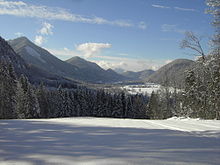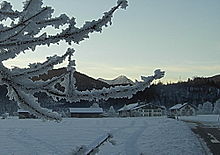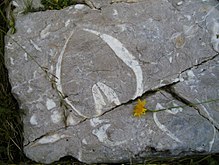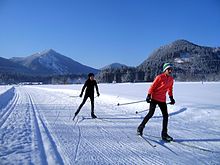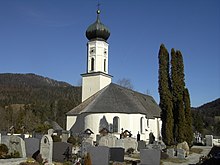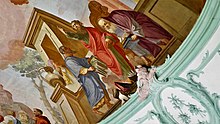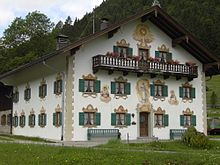Jachenau
| coat of arms | Germany map | |
|---|---|---|

|
Coordinates: 47 ° 36 ' N , 11 ° 26' E |
|
| Basic data | ||
| State : | Bavaria | |
| Administrative region : | Upper Bavaria | |
| County : | Bad Toelz-Wolfratshausen | |
| Height : | 790 m above sea level NHN | |
| Area : | 128.64 km 2 | |
| Residents: | 861 (Dec. 31, 2019) | |
| Population density : | 7 inhabitants per km 2 | |
| Postcodes : | 83676, 82432 | |
| Primaries : | 08043, 08858 | |
| License plate : | TÖL, WOR | |
| Community key : | 09 1 73 131 | |
| Community structure: | 28 parts of the community | |
| Address of the municipal administration: |
Dorf 7 1/3 83676 Jachenau |
|
| Website : | ||
| Mayor : | Nikolaus Rauchberger (Free Association of Voters) | |
| Location of the municipality of Jachenau in the Bad Tölz-Wolfratshausen district | ||
Jachenau is a municipality in the Upper Bavarian district of Bad Tölz-Wolfratshausen . The place of the same name is both the capital and the seat of the municipal administration.
After the municipal reform in 1975, Jachenau, with 842 inhabitants, is the smallest municipality with its own administration in Bavaria . Jachenau is a state-approved resort , which as "Jachenau das Sonnental" feels obliged to " gentle tourism ".
geography

Jachenau is 80 km south of Munich , between Bad Tölz and Garmisch-Partenkirchen , in the Bavarian Prealps on the south side of the Benediktenwand (1801 m) and close to the Walchensee . The municipality is located at an altitude of between 712 m near Fleckhaus and 1800 m on the Benediktenwand. Of the 128.64 km² municipal area, 10 621 ha, approx. 82.6%, are forest-covered. This makes the Jachenau one of the most forested areas in Germany.
The 15 km long forest and meadow valley of the Jachen , which extends from west to east and in which the village is located , is also known as “the Jachenau” .
Until the secularization in Bavaria in 1803, the Jachenau belonged to the Benediktbeuern monastery court . Then she changed to the responsibility of the district court (district office, district office) Tölz and was increasingly assigned to the Isarwinkel . The Tölzer Kurier reports today about the Jachenau under the heading "Isarwinkel".
| Kochel , | Benediktbeuern | |
| Walchensee (Kochel am See) |

|
Lenggries |
| Wallgau | Lenggries |
Parish parts
There are 28 officially named parts of the community ( scattered settlements ), 27 of which are inhabited, listed in alphabetical order and with the house numbers of the 60 properties assigned in 1808 . Houses that were built later were given a house number made up of the number of the original property and a fraction number that indicates whether it is the second, third or etc. property based on the original house number; z. B. 7 1 ⁄ 4 is the fourth house on the ground of the old house number 7. However, there is another special feature: 7 1 ⁄ 4 in reality consists of a semi-detached house and a single-family house, each with the letters a, b and c can be distinguished. In the newer districts of Rechen and Setzplatz, only fraction house numbers existed until 2005, e.g. B. 48 1 ⁄ 21 ; At that time, due to the "general confusion" in these two districts, the fractional house numbers were replaced by normal house numbers "Rake 1 to 18" and "Setzplatz 1 to 34". The same applies to Obernach, Friedeln and Bäcker, where the fraction house numbers have been replaced by whole numbers since 2016. State road 2072 was set as the border between the districts of Friedeln and Bäcker, Friedeln north and Bäcker south of the road. This means that the "Bäck" no longer belongs to the district to which it once gave its name "Beim Bäck", which is now called "Bäcker".
|
|
The hamlets of Letten and Leger are also still in the Jachental, but administratively belong to the municipality of Lenggries .
The "shadow courts"
Due to the west-east orientation, the 15 km long Jachental between the districts of Mühle in the west and Fleckhaus in the east has continuous sun in summer from early morning to late evening. That is why the Jachenau is known today as the "Sun Valley".
However, the valley is bordered on both sides by mountain ridges, which in the north with the Benediktenwand reach up to 1800 m and in the south between Staffel and Wilfetsberg at 1500 m and 1400 m altitude. In the winter months, the farms on the southern edge of the valley are therefore in the shade for several weeks. This has led to the expression “shadow courts”.
Today's "Luitpolder" farm (until around 1500 the "Krinner") was one of the first farms to clear and settle in the Jachental in the 12th century. This farm, the third largest farm in Jachenau, is like a whole series of other farms and Sölden between the districts of Niggeln and Mühle so close under the southern mountain ridge that it can last almost two months in winter when the sun is flat (November 25th) until January 17th) caught no sunbeam. This phenomenon particularly affects the “Lainer” and the “Luitpolder”. But in summer during the growing season these are the farms that enjoy the sun the longest every day.
It can therefore be assumed that the settlers of that time at the end of the 12th century knew exactly what they were getting into when choosing their property.
geology
The geological layers of the Jachenau all belong to the Lechtal cover, the middle "cover" of the Northern Limestone Alps . The geological peculiarity of the area around the Jachenau is the large-scale trough structure of the Bavarian Synklinorium with east-west axes of troughs and saddles. It is the cause of the Walchensee basin and the relatively wide basin near the center of Jachenau. The north Alpine rocks are almost exclusively marine sediments , which began to be deposited in the Triassic period about 250 million years ago in the global Tethys Sea on the sinking shelf of the large continent of Pangea . This process created several 1000 m thick rock packages, which were found in the Jachenau as Wetterstein limestone ( on the Benediktenwand), as Raibler layers (west and east of the Lainlalm), as the main dolomite (summit of the Hirschhörnl), as plate limestone (including Rautberg, Staffel , Hoher Zwiesler, Jochberg , Brunnenkopf, Brandkopf), as Kössen layers (on the steep banks of the Große Laine) and as Rhätolias reef limestone (Axelstein).
Megalodonts , also popularly known as "cow step clams", can be found as 200 million year old witnesses to geological history in the area around Jachenau in the Rhätolias reef limestone on the south side of the Axelstein north of the village and on a rock ball at the eastern entrance to the Rappinklamm. The stones can be from the Axelstein or the Rappinklamm, which were used as the foundation stones of alpine huts at the nearby Lainlalm and, with the fossilized shells, were supposed to serve as a protective magic to protect people and animals.
etymology
In the oldest documents from 1192 and 1294, the new settlement in the valley east of the Walchensee is named "Nazareth". The Jachental was covered with a maple forest , similar to the Großer Ahornboden in the Karwendel . It was not difficult for the Benedictine monks of the Benediktbeuern monastery to derive the place name Nazareth from "in acereto" = in the maple wood, in the maple floor.
In a document from 1295, “Nazareth” and “Jachnawe” appear side by side for the first time. Then "Jachnaw" (1416), "Jachenaw" (1433) and from 1584 "Jachenau" developed. There are many different approaches to deriving the name Jachenau: from "Jochinau" = the Au der Jocher von Altjoch am Kochelsee , from Ahornau based on the Ahornboden, from the Au des "Jacho", a first name in use at the time and as a derivation from the name the Jachen, this fast-flowing ("jach", Middle High German) body of water in the valley. The latter comes closest to the interpretation of Stephan Glonner (1856–1883), pastor in Lenggries; he writes in his chronicle of the Hofmark Hohenburg: “Jachenau, Compositum von Jachen und Au. Au = stream = water. Jachen the dative from jah = gah = jäh, ie zum abrupt Bach, so Jachenau ”( Stephan Glonner :).
history
Until the church is planted
The Jachenau was cleared and settled from the Benediktbeuern monastery from around 1185. Nazareth is mentioned for the first time in a copy of a document from 1192. The Augsburg Bishop Udalschalk left the new fracture tenth (from Jachenau) to the Benediktbeuern monastery in exchange for an estate near Utting . At the same time the order was given in the same document to build a stone church. Ninety-nine years later, Bishop Wolfahrt von Augsburg personally consecrated St. Nicholas' Church on March 17, 1291. In the same year an inn was built. In 1279 (1294) 17 "vaccariae" ( Schwaigen ) in Nazareth were listed in the Salbüchl of the monastery , of which the following seven can be linked to the farms that still exist today. These are "Nazareth sup monte" = mountain, "Im ahorn" = Achner, "Chlezagelshof" = Hinterbichl, "Gerunershof" = until 1500 named as the Krinner, then as Luitpolder, "Erchenboltshütte" = hereditary farm, "Im lohe" = spawn "Saherpach" = Sachenbach .
By dividing most of the 17 “Urhöfe” into two and sometimes three parts, the Jachenau came to 36 yards and 24 Sölden in the course of the 16th and 17th centuries by 1782 , which lasted into the 19th century. Until the secularization in 1803, the chairmanship of Jachenau belonged to the Benediktbeuern monastery court.
In the period 1808 to 1818 Jachenau developed into an independent political municipality. There was initially fierce resistance. With the municipal edict of May 13, 1808, the tax districts of Jachenau and Walchensee were primarily determined according to geographical aspects, but not according to historical ties, and were reorganized several times due to the emerging resistance. In one of the lists, the settlements around the lake were assigned to the Walchensee tax district and a little later - after Walchensee was incorporated into the Kochel tax district - perhaps this too. But by 1818 at the latest everything was the same as it was until 1808. As early as 1808, house numbers 1 to 60, which were mostly still valid today, were assigned to the 60 properties in Jachenau at that time . They start with 1 and 2 in Sachsenbach and end at 59 in Altlach (Bräu) and at 60 at Ochsensitz .
Jachenau forest conditions in the course of history
The area of Jachenau is 128.64 km². However, in 1894 the state declared the large areas of the state forest to be “outside the Brandenburg region”. Following resolutions by the community committee, the Jachenau community protested twice, unsuccessfully, on April 24 and July 29, 1894, against the official order that the state forests were not to be regarded as community corridors. From now on, the following text was printed in the legend on the maps: “According to the decision of the Bavarian Administrative Court of May 30, 1896, the state forests in this plan within the tax community, corridor and purple border do not belong to the political community of Jachenau. (Munich in February 1897, Kgl. Katasterbureau). ”This means that the unincorporated areas only existed for 76 years (until January 1st, 1970). In 1966 the municipal area was much smaller at 13.98 km² and only included the Jachenau Valley and a few small exclaves . The community reached its present size through the incorporation of the same-named wooded, community-free area of Jachenau in the following years (dissolution on January 1, 1970; earlier smaller areas were incorporated, including Schröfeln 1955). Of the current area, 82.6% or 10,621 hectares are forest-covered and again half of it is owned by the Jachenau farmers and mercenaries. This valuable property, which has guaranteed the Jachenauer a certain prosperity for centuries, is a matter of course for today's generation. That was not always so.
At the time of clearing and settlement in the 12th to 14th centuries, logging in the Jachenau forests was not yet regulated or restricted. But with the development of the cities, especially Munich , the demand for construction wood and firewood (also for the "wood-eating" lime kilns) from the forests on the Isar increased so much that the sustainability and thus the permanent existence of the forests seemed threatened. The Bavarian dukes and the Benediktbeuern monastery issued - starting in the 15th century - wood regulations that steered the logging into sustainable paths. Because of the harsh climate and the restricted agriculture in 1487, the farmers in the Jachenau were granted special rights for logging “for sale on the water” in addition to their own need for construction timber and firewood, with the “Jachnaw privilegium”. Every year every farmer was allowed to cut a certain number of trunks for sale free of charge within the framework of the “house number” in his “pieces of wood laid with the goods”; all he had to do was leave the "provost tree", the most beautiful trunk, to the monastery. The undivided number of houses entitles the farmer to 240 trunks per year. When the farms were divided, the number of houses decreased to 120 or 80 tribes. In addition, the farmers and also the mercenaries were allowed to cut further wood for sale in the open and common mountains upon request and for a low price.
With the secularization, these forest rights, which are vital for the Jachenau, threatened to lapse into "grace that can be revoked at any time" through the takeover of the state. In a nearly 200-year “struggle against rulership”, the Jachenau residents did not allow themselves to be beaten down by the Bavarian State Forestry Administration despite severe setbacks . Therefore, in the 1950s, all parliamentary groups in the Bavarian State Parliament decided to put an end to the unfortunate tactics of the forest administration through a law and finally to pacify the area north and south of the Benediktenwand. In 1964, the state parliament passed the Partial and Interest Forest Act (TZiWG 1964), a settlement that largely returned the ownership of their forests to the Jachenau farmers and mercenaries and the church. The process of real estate division (according to Art. 5 TZiWG) lasted until 1983, but even today, in one case, the replacement of forest rights for a partial area has not yet been completed.
For the most part, however, the question of the communal ban and Wuhr woods Psengberg , Fischlain and Rotwand is also unresolved . For reasons unknown up to now, these were not taken into account in the TZiWG and passed into the property of the state "untreated and tacitly". So it came about that the densely wooded municipality of Jachenau did not have a square meter of forest from 1803 to 2017, i.e. 214 years. This unsatisfactory situation improved slightly in 2017 with the purchase of a piece of forest with around 4.7 hectares.
Since March 2011, the municipality has had an expert opinion on the historical basis of the spell and whitewoods of the 18th century and their legal treatment over the past 200 years. In the early summer of 2012, the community informed representatives of the parliamentary groups of the FW , the SPD and the CSU in one-on-one talks in preparation for a petition to the Bavarian state parliament . The latter alone saw no possibility of supporting the municipality in its efforts to supplement the TZiWG with the Bann- and Wuhrholz with the aim of transferring these forests into the ownership of the municipality. On September 3, 2012, the state government replied to the written question of the Member of Parliament Florian Streibl (FW) on May 18, 2012 on "Bann- und Wuhrholz - Rights of the municipalities" with factually incorrect and from the actual topic, namely the equal treatment of church timbers and the Communal spells and whistles, distracting statements.
According to the mayor at the citizens' meeting on March 20, 2015, the municipality has submitted an application to redeem its forest rights. The community expects at least the same treatment as the communities north of the Benediktenwand between Kochel am See and Bad Heilbrunn received in the 1980s. This means the replacement of the forest rights over 72.5 hectares (as of 1935) according to the Bavarian Law on Forest Rights Art. 19 only in money, unfortunately not as an allocation of forest areas to the property of the municipality.
In the meantime, new research in a forest archive in November 2015 has shown that the wood procurement right for the Oberhöfner and the Peterer Brücke was replaced in 1971 for approx. 23,000 DM in favor of the community. A notarial deed and the resolution in the municipal decision book of August 27, 1971 were found as evidence. Nevertheless, this replacement at that time only made up a fraction of the total complex of spell and Wuhr woods.
School history
School history for Jachenau began in 1757 in Höfen 21. In 1790 a school house was built at the Bäck, which was used until 1898. At that time, a new schoolhouse, which had long since become necessary, was built in the (more central) Wieden to shorten the way to school, which was replaced in 1951 by a new school building, the Ferdinand Feldigl School. Today the crèche and kindergarten are housed in the old school house.
Alpine and skiing history
In 1883, Simon Guggenberger von Jachenau-Point was trained and appointed as the first mountain guide in Jachenau by the DAV Tölz section and authorized as such by the Tölz district office .
As early as 1885, the forest master Maximilian Lizius in Jachenau was one of the first in Germany to use skis that had been given to him by a Norwegian forester when he was walking through the area .
In 2001, Marietta Uhden was the first woman in the world to climb a route with the eleventh level of difficulty: the route Sun in the Heart (XI- / 8c +) in Jachenau.
In March 2016, Elisabeth Willibald von Jachenau-Wieden became junior world champion in slalom at the Junior World Championships in Sochi .
Population development
Between 1988 and 2018, the municipality grew from 839 to 870 by 31 inhabitants or 3.7%.
politics
Municipal council
The council consists of the first mayor and eight council members. In the last local election on March 15, 2020 , the turnout was 80.6%.
The First Mayor is (Free Community of Voters)
badges and flags
coat of arms
|
Blazon : "Shield in the form of a" J ", horizontally divided into gold and blue, a rising, black chamois buck growing out of the dividing line."
On April 19, 1958, the municipal council decided to apply for a municipal coat of arms for the municipality and to ask the Bavarian Main State Archives for advice. On February 14, 1959, the unanimous decision was made to adopt the coat of arms made by the graphic artist Ernst Rössner in Bad Tölz as the municipal coat of arms in the form now set. The coat of arms has a historical reference to Jachenau: It was awarded on March 1, 1502 by Duke Albrecht IV , "the wise" to the probationer Caspar März von Benediktbeuern. This was the son of the Jachenau monastery hunter Anderl March (1445–1510) from the "Loaner" 48. From 1486 to 1513 Caspar März was in the service of the monastery in ascending positions from Marstaller to Hubprobst and Sealer. From 1514 he lived as a landlord in Kochel and in 1522 he took over an inn in Lenggries. |
|
flag
The adoption of the coat of arms also included the procurement of a black and yellow municipal flag, which, however, did not take place.
economy

The economic strength and relative prosperity of the Jachenau were based on agriculture and forestry for over 700 years . In addition to the focus on grassland farming with cattle breeding and dairy products, grain and flax were also grown for their own supplies until the middle of the 20th century . Today Jachenau has 34 agricultural properties, of which 29 are farmers and 5 are Sölden . The share of full-time businesses is 67.6% (21st place out of 2953 in Bavaria).
The extensive forest rights of the Jachenau property (since 1983 in a comparison with the Bavarian state converted into approx. 5000 hectares of forest property) enable the sale of approx. 15,000 to 20,000 solid meters of wood annually. In the past, not inconsiderable additional earnings resulted from woodwork for the Benediktbeuern monastery, and from 1803 for the Bavarian State Forestry Administration.
Since the time around 1900, when the two new inns with overnight accommodation for "summer guests" were built, tourism was added as a third pillar. All over the valley, guest rooms and holiday apartments are an important basis for secure additional income almost all year round.
This three-way division of Jachenau's economic power still applies today. In addition, numerous craft businesses (in particular wood processing such as sawmills , carpenters , joiners and a wood carver ) provide jobs in the valley. Nevertheless, the share of out-commuters among income taxpayers is very high at 82.1% in 2006 (place 2047 out of 2056 in Bavaria).
In terms of business tax revenue , the two run-of-river power plants operated by E.ON Wasserkraft in Obernach and Niedernach were the municipality's largest commercial operations for decades. For years, however, this has been reduced to zero thanks to E.ON's tax avoidance strategies .
Jochberg pumped storage plant
In February 2013, the planned Jochberg pumped storage plant was presented to the public. A reservoir with a volume of three million m³ was to be created in the hollow east of the Jocheralm, 600 m below that a cavern with pumps and generators, from there a tunnel to the Walchensee, to the Walchensee power plant in Altjoch, to Fernwöhr on the Kleine Laine and a 600 m long pressure tunnels run vertically between the reservoir and the cavern. A capacity of 700 megawatts was planned and an implementation within ten years, whereby five years should be allocated to the planning ( spatial planning procedure and plan approval procedure ) and five years to the construction period. The municipality of Jachenau intended to set up working groups to discuss issues such as of: Reduction of pollution during the construction period, access concept, influence on tourism and nature conservation.
In the meantime, the Bavarian State Government has withdrawn from realizing the Jochberg project due to the current lack of profitability of the pumped storage power plants.
traffic
The bus route 9595 of the regional traffic Upper Bavaria connects Jachenau with Lenggries . From there the Bayerische Oberlandbahn runs every hour to Munich .
The state road 2072 leads from Lenggries to Jachenau and on via Sachsenbach and along the east bank of the Walchensee to Urfeld (from the junction "Zwerchweg", 1.5 km west of Jachenau, closed to general traffic). A toll road leads 12 km from the “Zwerchweg” via Niedernach and Altlach along the south bank of the Walchensee to Einsiedl , where it joins the federal road 11 .
Public facilities
Educational institutions
- Crèche in Jachenau-Wieden
- Kindergarten in Jachenau-Wieden
- The Ferdinand Feldigl primary school in Jachenau in Wieden had three full-time teachers and 44 students in the 2016/17 school year. It is named after Ferdinand Feldigl , the former teacher of Jachenau in the period from 1882 to 1891 and creator of the song "The beautiful quiet Jachenau".
Offices
- Local government
- Guest information
Leisure and sports facilities

- 35 km of cross-country trails , groomed side by side for both classic and free cross-country skiing techniques
- Natural ice stadium (small area) in Jachenau-Dorf (north below the church)
- Sports field with floodlights in the Wieden district
- Ski lift in Jachenau-Mühle
- Swimming, diving, surfing, kiting, sailing and fishing in the nearby Walchensee
- numerous possibilities for valley and mountain hikes, bike or mountain bike tours in summer
- in the same way numerous possibilities for snowshoe hikes and ski tours in winter
Parish Church of St. Nicholas
In 1192 the diocese of Augsburg gave the order to build a stone church in "Nazareth". In 1291, 99 years later, the church was consecrated by Bishop Wolfhard von Augsburg to St. Nicholas as the main patron. Secondary patrons are the Saints Peter and Paul . In 1718 the heart-shaped choir with oratorios and sacristy was added to the west . At the same time, the altar was probably moved from its usual location in the east to the west. The current furnishings of the three altars were made in the period 1773/74. The main altar is decorated with a picture of St. Nicholas in veneration of the Mother of God . The two side altars are dedicated to Mary Immaculate and the Three Kings .
For the latter, the "Brotherhood of the Three Kings" has existed in Jachenau since 1694. The late baroque interior of the church from the last quarter of the 18th century is characterized by the light Wessobrunn stucco work in the delicate Benediktbeurer green and the ceiling frescoes by Alois Gaibler from Kaufbeuren in the main room and the chancel.
In 1874 the church tower on the east side was demolished; in its place was the "sign", the entrance to the church. At the same time, a new church tower with a square base, octagonal bell tower and onion dome was built on the north side. The oldest evidence in the church is a fresco from the 14th century in a niche on the medieval choir wall next to the confessional, which depicts a man kneeling in red robes; possibly a personified soul praying in front of the heavenly wall in Jerusalem .
The modern organ from 1982 was created by Gerhard Schmid from Kaufbeuren. The ringing consists of five bells from the Oberascher bell foundry in the tones d '- f sharp' - a '- h' - d '' and sounds in the D major fifth chord . Jachenau, until the secularization in 1803 always looked after pastoral care by the Benediktbeuern monastery or the pastor of Kochel, has been an independent parish since 1806.
Culture
In Jachenau amateur theater has been performed at least since the 1920s. After the Second World War , a theater group was formed again, which had to join an association on the instructions of the military government. She became part of the Jachenau mountain costume club founded in 1948. Every year a piece is rehearsed in winter that is performed during Easter.
societies
- Volunteer fire brigade since 1875
- Tourist association since 1949
- Mountain rifle company since 1906
- Mountain costume association since 1948
- Craftsmen and farmers association since 1757
- Schützengesellschaft cosiness since 1924
- Ski and sports club since 1949
- Veterans and warriors association since 1822
music
- church choir
- Music band
- Jachenauer Stubenmusi
- Jachnara Schodseitnmusi
- Jachenauer dulcimer music
- Jachenauer harp music
- Jachenauer Sudhausmusi
- 1605 music
- Laichalm music
- Goaßlschnalzer
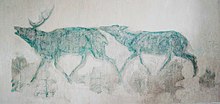
Buildings
- Parish Church of St. Nicholas
- Facade paintings ( Lüftlmalerei )
- Hydroelectric power plants in Niedernach and Obernach (no visit)
- Cenotaph on the western edge of the cemetery with a sculpture from 1952 by the sculptor Hias Lautenbacher von Kochel made of reddish marble, which depicts Saint George slaying the dragon and four stone slabs with the names of the fallen and missing Jachenauer from the five wars between 1805 and 1945.
art
In 1904, 1905 and 1908, the painter Franz Marc stayed at the Bergstaffelalm under the Rabenkopf with his friend, the dairyman Hans Müller, and decorated the stove and walls of the alpine hut with frescoes.
Soil monuments
Personalities
Sons and daughters of the village
- Kaspar Amort the Elder (1612–1675), painter
- Johannes Nar (1890–1964), theologian
- Hans Orterer (* 1948), military musician
- Claudia Gudelius (* 1951), doctor and writer
- Elisabeth Willibald (* 1996), ski racer
People who worked on site
- Rupert Egenberger (1877–1959), special educator, curative teacher
- In 2001 in Jachenau, Marietta Uhden broke the world record for women in difficulty climbing. She was the first woman in the world to climb a route with the eleventh level of difficulty: the route Sonne im Herzen am Achselstein (XI- / 8c +).
- Jost Gudelius , has lived in Jachenau since 1974 and has been active in local history since 2000
fauna and Flora
A special feature of Jachenau is the ibex colony on the Benediktenwand, which has been developing since 1959 and which has now grown to more than 100 animals. Not regularly, but again and again a pair of eagles broods on Jachenauer Flur . Another special feature is the church tower as a sleeping place for the little horseshoe bats . In 2002, 34 adult specimens were counted. Among the flowers the mountain auricle , the stemless gentian , the lashed alpine rose , the lady's slipper , the Turkish lily , the very small autumn rootwort and the even smaller and inconspicuous round-leaved and also the long-leaved sundew are to be mentioned.
Others
Due to its scenic beauty, the Jachenau is repeatedly the object for documentaries or the background of feature films by filmmakers from nearby Munich. In the first half of October 2007, scenes of “ Brandner Kaspar ” with Michael Herbig were shot by director Joseph Vilsmaier on the Scharnitz-Almen. For this purpose, both the Vordere and the Hintere Scharnitz-Alm had been converted into a mountain farming village with a small church including a cemetery. Individual Jachenauers took on extra duties. In 1960, the Bay of Saxony on the Walchensee was also used as the location for a film with a historical theme for the series Tales of the Vikings / The Bull with Christopher Lee . In the summer of 2008, the director Michael Herbig shot Wickie and the strong men in the Bay of Saxony . For this purpose, a Viking village with additional equipment was built there. After a thorough Europe-wide search, this location was chosen.
The journalist and documentary filmmaker Otto Guggenbichler , in 1953 with an ethnographic dissertation on the Jachenau doctorate was, describes in his cinematic documentation of the situation at the beginning of the 1970s.
literature
- Jost Gudelius: The Jachenau . Ed .: Municipality of Jachenau, Jachenau 2008, ISBN 978-3-939751-97-7 .
Web links
Individual evidence
- ↑ "Data 2" sheet, Statistical Report A1200C 202041 Population of the municipalities, districts and administrative districts 1st quarter 2020 (population based on the 2011 census) ( help ).
- ↑ Jachenau: Official statistics of the LfStat
- ^ Jachenau community in the local database of the Bavarian State Library Online . Bavarian State Library, accessed on September 25, 2017.
- ^ Jost Gudelius: The Jachenau . Jachenau 2008.
- ↑ a b Tölzer Kurier, New house numbers for three districts from January 25, 2016
- ^ BayernAtlas
- ↑ Kurt Kment: Geology of Jachenau . In: Jost Gudelius: The Jachenau . Jachenau 2008, pp. 336–346
- ↑ BHStA , KL Benediktbeuern 39, Bl.40
- ↑ BHStA, KL Benediktbeuern 32
- ↑ BHStA, KL Benediktbeuern 9
- ↑ BHStA, KL Benediktbeuern 174
- ↑ Wolf-Armin Frhr. v. Reitzenstein : Lexicon of Bavarian place names. Origin and meaning . CH Beck, Munich 2006, ISBN 3-406-55206-4 , p. 127 .
- ↑ Chronicle of the Hofmark Hohenburg im Isarthal from 1867 . Manuscript, Bad Tölz city archive; as download at https://www.hohenburg-lenggries.de/wp-content/uploads/ChronikGlonner-Umschrift-online.pdf .
- ↑ The year 1279, later inserted in the Salbüchl, was confirmed by Schuhbauer, Albert, "Possession and income of the Benediktbeuern monastery at the end of the 13th century, transfer of the oldest pen book, BHStA KL BB 32, Weßling 2009". The BHStA dates to 1294.
- ↑ State Archives Munich, cadastre 21 306
- ^ Jost Gudelius: The Jachenau . Jachenau 2008, ISBN 978-3-939751-97-7 , p. 41f
- ^ Bavarian State Statistical Office: Official directory of the unincorporated areas of Bavaria. Issue 276 of the articles on Bavaria's statistics. Munich, November 1966. This volume shows an area of 11,495.85 ha for the former community-free area of Jachenau (p. 14). Originally there were four other separate, albeit spatially contiguous, community-free areas that were included in the community-free area of Jachenau from 1966 at the latest: Altlachberg , Böbelsberg , Simetsberg and Steinriegel : Bayerischer Staatsanzeiger No. 39 of September 30, 1966.
- ↑ StAnz. 1970 / No. 20: Announcement of the Bayer. State Ministry of the Interior of May 6, 1970 No. IB 3 - 3000 - 47 a / 5
- ↑ BHStA, KL Benediktbeuern 192
- ↑ BHStA, estate Kiene
- ↑ Bavarian Law and Ordinance Gazette, Law on Partial and Interest Forests in the Forestry Districts Benediktbeuern, Fall, Jachenau and Walchensee of November 27, 1964 , Munich No. 17/1964 pp. 205 to 213 ( online ).
- ↑ In addition to Jachenau, the law also includes the municipalities of Kochel , Benediktbeuern , Bichl , Bad Heilbrunn and a farmer in Wallgau
- ↑ Bann- and Wuhrholz in Jachenau, history and goals . In: gudelius.de . Retrieved March 20, 2018.
- ^ A b Jost Gudelius: History of communal forest rights in Jachenau ( Memento from April 4, 2016 in the Internet Archive ). January 31, 2016.
- ↑ Printed matter 16/13263 . September 3, 2012. Accessed March 20, 2018 (PDF; 55.3 kB).
- ↑ Jachenau tries to get old forest rights . In: Merkur.de , March 16, 2015. Accessed March 20, 2018.
- ^ Jost Gudelius: The Jachenau . Jachenau 2008, ISBN 978-3-939751-97-7 , pp. 224-228.
- ^ Maximilian Lizius: At the Hüttenherd . Munich 1949, p. 185
- ^ Jost Gudelius: The Jachenau . Jachenau 2008, ISBN 978-3-939751-97-7 , p. 41.
- ^ Jachenau local council. Jachenau community, accessed on August 26, 2020 .
- ^ Entry on the coat of arms of Jachenau in the database of the House of Bavarian History
- ↑ Entry on Jachenau on the Kommunalflaggen.eu page
- ^ Bastian Obermayer: Luxemburg leaks on Eon. Windy loans . In: Süddeutsche Zeitung , November 7, 2014. Retrieved March 20, 2018.
- ↑ Jochberg energy storage device ( Memento from April 3, 2016 in the Internet Archive ). In: energieallianz-bayern.de .
- ↑ Bavarian State Office for the Environment: Analysis of the pumped storage potentials in Bavaria ( Memento of the original from October 6, 2014 in the Internet Archive ) Info: The archive link was inserted automatically and has not yet been checked. Please check the original and archive link according to the instructions and then remove this notice. . June 2014. Retrieved March 20, 2018 (PDF; 2.38 MB).
- ↑ Research center for the energy industry: Expert opinion on the profitability of pumped storage power plants ( memento of the original from October 6, 2014 in the Internet Archive ) Info: The archive link was automatically inserted and not yet checked. Please check the original and archive link according to the instructions and then remove this notice. . September 2014. Accessed March 20, 2018 (PDF; 1.11 MB).
- ↑ Ferdinand Feldigl Primary School Jachenau in the school database of the Bavarian State Ministry for Education and Culture , accessed on January 2, 2018.
- ↑ Ferdinand Feldigl. Historical association for the city and the district of Fürstenfeldbruck, accessed on January 2, 2018 .
- ↑ The Song of Jachenau (PDF file; 65 kB)
- ↑ Hildegard Möller: Painters and muses of the "Blue Riders" . Munich 2007, pp. 168, 178 and 179.
- ^ Jost Gudelius: The Jachenau . Jachenau 2008, p. 215.
- ^ Tölzer Kurier, August 29, 2008, page 4
- ↑ The Jachenau, a special alpine landscape . Phil.Diss. Munich 1953
- ^ Alpha-retro: The Jachenau 1974. A film about a strange valley




